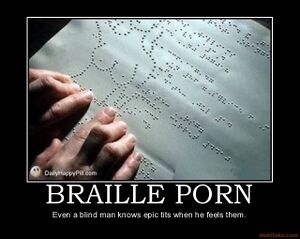- Portals
- The Current Year
- ED in the News
- Admins
- Help ED Rebuild
- Archive
- ED Bookmarklet
- Donate Bitcoin
Contact an admin on Discord or EDF if you want an account. Also fuck bots.
Braille

|
This article needs moar everything. You can help by adding moar everything. |
Braille is a language for blind people that was created at least one hundred years ago by some French douche who was sad that he couldn't fap to porn. The language is comprised of raised dots that can be "read" by the fingers of blind people, Jedi Knights and people who've run afoul of Mark Wahlberg.

Once the Houston 500 was completely transcribed into Braille, the language became obsolete and was stamped onto all ATMs and elevators for the lulz.
Learning Braille
Braille characters are expressed by raising different combinations of dots in cells that are 3 dots high and 2 dots wide. They are numbered accordingly:
1 o o 4
2 o o 5
3 o o 6
If you are not blind or have become blind you can learn Braille through a badass story. It is learned by associating the elements of the story with their symbols which represent the raised dots in the Braille cells:
You Apprached a Bridge, but it was Closed. You took a Detour then went Empty, so you got Fuel. You were in Gridlock, so you traded your car in for a Harely. You turned the Ignition on and Jumped over the river.
The above are for letters "a" through "j" which are in 1, 2, 4, and 5; for letters "k" through "t" raise a dot in 3, and for letters "u" through "z" raise dots in 3 and 6. For numbers preface the cells with a cell that has raised dots in 3-6; for letters preface the cells with a cell that has raised dots in 5 and 6; for capital letters preface the cells with a cell that has a raised dot at 6; for punctuation shift "a" through "j" down one.
Gallery
-
A legitimate question.
-
Fucking hipsters...
-
Braille cat
-
Braille porn
-
This device can be used to troll Braille readers.
External Links
| Braille is part of a series on Language & Communication | |
|---|---|
Languages and Dialects • Grammar, Punctuation, Spelling, Style, and Usage • Rhetorical Strategies • Poetry •
The Politics of Language and Communication • Media • Visual Rhetoric
Click topics to expand |
|